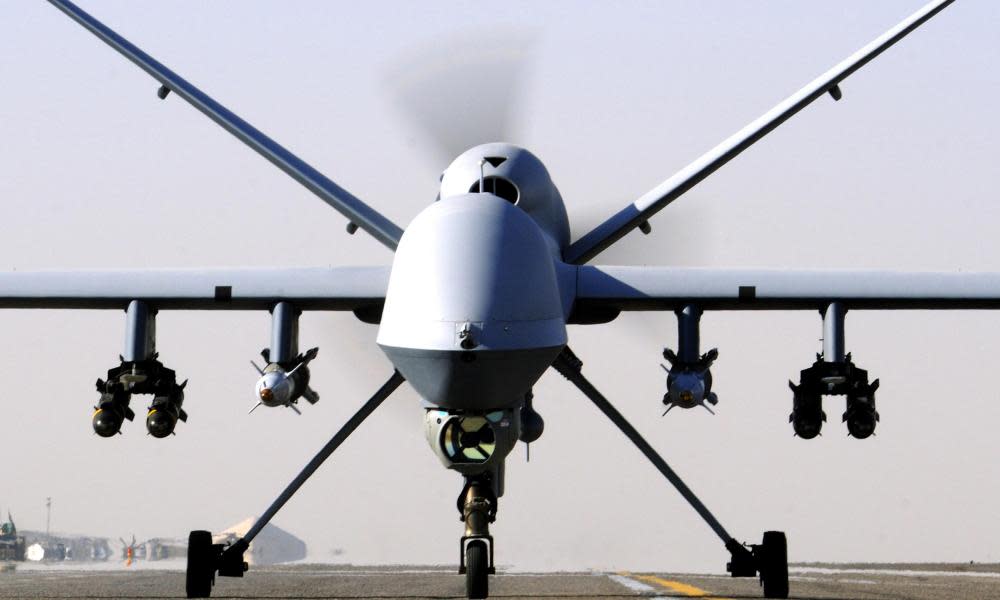RAF airstrikes killed 29 civilians in Iraq and Syria in two years, analysis suggests

Twenty-nine civilians are feared to have been killed in nine RAF airstrikes in Iraq and Syria between 2016 and 2018, 10 more than previous estimates, and far higher than the single non-combatant fatality accepted by the UK, according to analysis.
In the worst incident, 12 civilians were accepted as likely to have been killed in Raqqa, Syria in 2017 by a US strike, while research points to an RAF drone strike killing at least four member of the same family in Abu Kamal, Syria, in 2016, according to on-the-ground reports.
The report’s authors, the London-based charity Action on Armed Violence (AOAV), says the analysis showed the RAF had “major questions to answer” about the conduct of the war against Islamic State (IS), but the Ministry of Defence insisted there was “no evidence” of civilian casualties.
Earlier this week, a Guardian investigation identified six RAF airstrikes in Mosul, Iraq, that killed civilians during same period as that covered by the analysis. The latest data also examined British bombing in Syria as part of Operation Shader, the UK contribution to the war against IS that began nearly nine years ago.
RAF Typhoon jets launched an attack on 13 August 2017, purportedly against enemy fighters operating mortars. Syrian media reported there had been up to 12 civilians killed – a figure subsequently accepted by the US Central Command, which has overall responsibility for the campaign against the terrorist group.
US Central Command released a statement, acknowledging dozens of civilian casualties, mostly from US strikes, but also referenced the attack on Raqqa by date. “Regrettably, 12 civilians were unintentionally killed and six were unintentionally injured as a result of the blast,” it stated.
The RAF claims to have only caused a single civilian fatality in the fight against IS – during the bombing of a “group of terrorists” in a vehicle in March 2018 in Syria’s Euphrates Valley. However, concerns about that assertion have lingered for several years after US admissions and other leaks. The US says 1,437 civilians have been “unintentionally killed” in 35,000 airstrikes.
The RAF is an integral part of the campaign against IS. MPs voted for RAF participation in strikes against targets in Iraq in September 2014 and Syria in December 2015, with jets and drones having flown more than 5,500 combat missions and fired more than 4,300 missiles.
Dr Iain Overton, the executive director of AOAV, said delayed or incomplete reporting made it difficult for independent groups to assess the impact of British airstrikes. However, he said, the research showed “there are some major questions that the RAF should answer in relation to civilian harm from its airstrike missions, questions that all too often are ignored and rejected”.
Britain says it takes reports of civilian casualties very seriously. An MoD spokesperson added: “The UK always minimises the risk of civilian casualties through our rigorous processes and carefully examines a range of evidence to do this, including comprehensive analysis of the mission data for every strike.”
Two Reaper drones struck targets in Abu Kamal, Syria, on 21 April 2016 using Hellfire missiles that were aimed at an improvised weapons factory and car bomb.
“At least four and up to 10 members of one family” were killed when their house was targeted, said Airwars, a research group that monitors western bombing in the war on IS. Its estimate is based on a compilation of reports from Syrian media.
At the time of the strike, the RAF said “there was no indication of any civilian casualties in our own detailed assessments” of the incident. However, the research concluded that the weight of local reporting led to the conclusion that “the RAF were responsible, or, at the very least, involved in the targeting which led to civilian casualties”.
Although the research focused on a two-year period ending in 2018, questions remain about RAF airstrikes. Earlier this month, it emerged that the MoD was refusing to say whether it had investigated reports of civilian casualties after an RAF drone strike against a terrorist target in northern Syria in December.
The fresh analysis of strike data was taken from combining assessments made by the US, internal Pentagon data leaked to the New York Times, analyses from Airwars and reports from international and local media.

 Yahoo News
Yahoo News 
